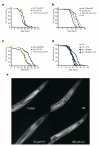Amyloid-binding compounds maintain protein homeostasis during ageing and extend lifespan
- PMID: 21451522
- PMCID: PMC3610427
- DOI: 10.1038/nature09873
Amyloid-binding compounds maintain protein homeostasis during ageing and extend lifespan
Abstract
Genetic studies indicate that protein homeostasis is a major contributor to metazoan longevity. Collapse of protein homeostasis results in protein misfolding cascades and the accumulation of insoluble protein fibrils and aggregates, such as amyloids. A group of small molecules, traditionally used in histopathology to stain amyloid in tissues, bind protein fibrils and slow aggregation in vitro and in cell culture. We proposed that treating animals with such compounds would promote protein homeostasis in vivo and increase longevity. Here we show that exposure of adult Caenorhabditis elegans to the amyloid-binding dye Thioflavin T (ThT) resulted in a profoundly extended lifespan and slowed ageing. ThT also suppressed pathological features of mutant metastable proteins and human β-amyloid-associated toxicity. These beneficial effects of ThT depend on the protein homeostasis network regulator heat shock factor 1 (HSF-1), the stress resistance and longevity transcription factor SKN-1, molecular chaperones, autophagy and proteosomal functions. Our results demonstrate that pharmacological maintenance of the protein homeostatic network has a profound impact on ageing rates, prompting the development of novel therapeutic interventions against ageing and age-related diseases.
Figures




Comment in
-
A fountain of youth (for worms).Nat Methods. 2011 May;8(5):376. doi: 10.1038/nmeth0511-376. Nat Methods. 2011. PMID: 21678622 No abstract available.
-
Medical implications of basic science: protein homeostasis as a clinical target for increased longevity?Rejuvenation Res. 2011 Jun;14(3):335-9. doi: 10.1089/rej.2011.1211. Rejuvenation Res. 2011. PMID: 21751864 No abstract available.
References
-
- Balch WE, Morimoto RI, Dillin A, Kelly JW. Adapting proteostasis for disease intervention. Science. 2008;319:916–919. - PubMed
-
- Porat Y, Abramowitz A, Gazit E. Inhibition of amyloid fibril formation by polyphenols: structural similarity and aromatic interactions as a common inhibition mechanism. Chem. Biol. Drug Des. 2006;67:27–37. - PubMed
-
- Frid P, Anisimov SV, Popovic N. Congo red and protein aggregation in neurodegenerative diseases. Brain Res. Brain Res. Rev. 2007;53:135–160. - PubMed
-
- Kenyon C. The plasticity of aging: insights from long-lived mutants. Cell. 2005;120:449–460. - PubMed
Publication types
MeSH terms
Substances
Grants and funding
LinkOut - more resources
Full Text Sources
Other Literature Sources
Medical

